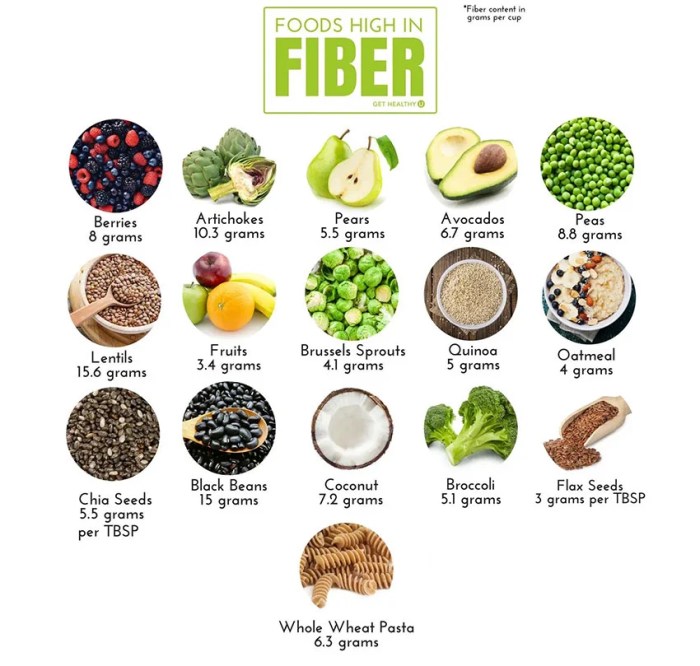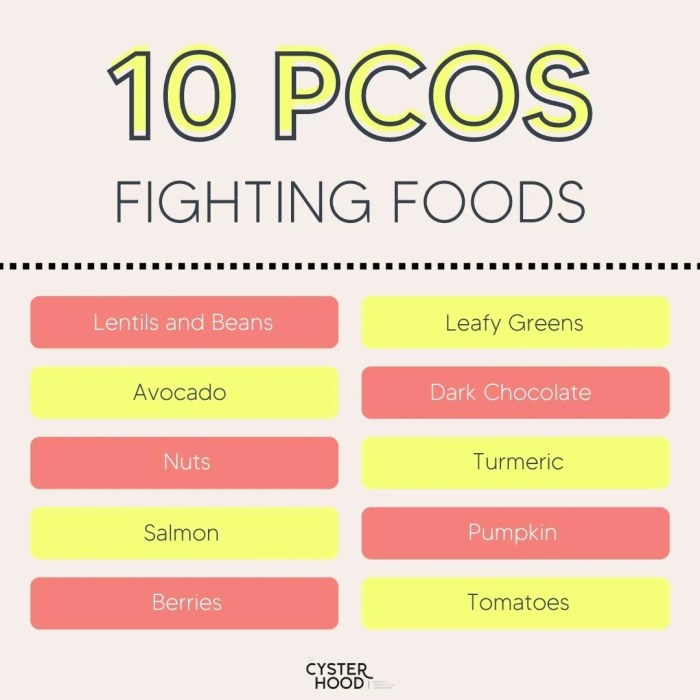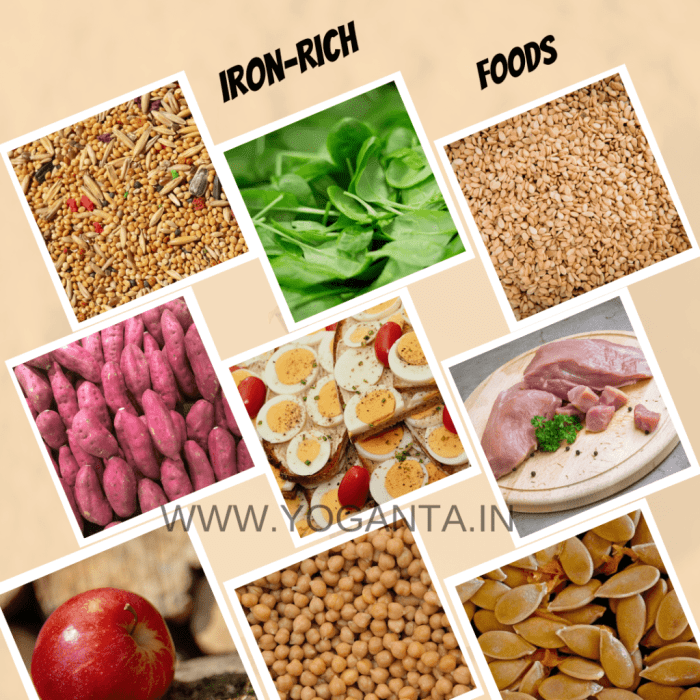Soluble and insoluble fiber are crucial components of a healthy diet, impacting everything from blood sugar levels to digestive health. This comprehensive guide explores the differences between these two types of fiber, detailing their sources, properties, and effects on the body. We’ll delve into how they impact digestion, weight management, and even specific health conditions.
Understanding the nuances of soluble and insoluble fiber allows us to make informed choices about the foods we eat, ultimately leading to a healthier lifestyle. This exploration will empower you to recognize the unique roles each plays in maintaining optimal well-being.
Introduction to Dietary Fiber
Dietary fiber, an essential component of a healthy diet, is the indigestible part of plant foods. It plays a crucial role in digestive health, promoting satiety, and contributing to overall well-being. This diverse group of carbohydrates is broadly categorized into soluble and insoluble fiber, each with unique properties and effects on the body. Understanding these differences allows for a more informed approach to dietary choices and better management of digestive processes.Soluble fiber dissolves in water, forming a gel-like substance in the digestive tract, while insoluble fiber does not dissolve.
Focusing on soluble and insoluble fiber is crucial for overall health, but did you know it can also impact your oral health? A well-fitted night guard for teeth, like the ones discussed in this helpful article night guard for teeth the right fit , can significantly reduce the impact of grinding and clenching, which are often exacerbated by a poor diet lacking in these important fibers.
This, in turn, helps maintain healthy teeth and gums, further emphasizing the importance of a balanced diet rich in both soluble and insoluble fiber.
This fundamental difference in their chemical structure leads to distinct impacts on the body. Both types, however, contribute significantly to maintaining a healthy gut microbiome, which in turn supports overall health.
Types of Dietary Fiber
Different types of plant foods contain varying proportions of soluble and insoluble fiber. Recognizing these sources helps in tailoring dietary choices to meet individual needs and preferences.
- Soluble fiber is found in foods like oats, barley, fruits (especially apples, citrus fruits, and berries), and legumes (beans, lentils, and peas). These foods often contribute to a feeling of fullness and promote slower digestion, which can be beneficial for managing blood sugar levels.
- Insoluble fiber is abundant in whole grains (like wheat bran and brown rice), vegetables (especially broccoli, carrots, and green beans), and seeds. This type of fiber primarily supports healthy bowel movements and helps prevent constipation.
Comparison of Soluble and Insoluble Fiber
The table below summarizes the key differences between soluble and insoluble fiber, highlighting their sources and general effects on the body.
| Type | Examples | General Effects on the Body |
|---|---|---|
| Soluble Fiber | Oats, barley, fruits (apples, citrus), legumes (beans, lentils) | Slows digestion, promotes satiety, may lower cholesterol and blood sugar levels, supports healthy gut bacteria. |
| Insoluble Fiber | Whole grains (wheat bran, brown rice), vegetables (broccoli, carrots), seeds | Promotes regular bowel movements, prevents constipation, adds bulk to stool, supports healthy digestion. |
Soluble Fiber
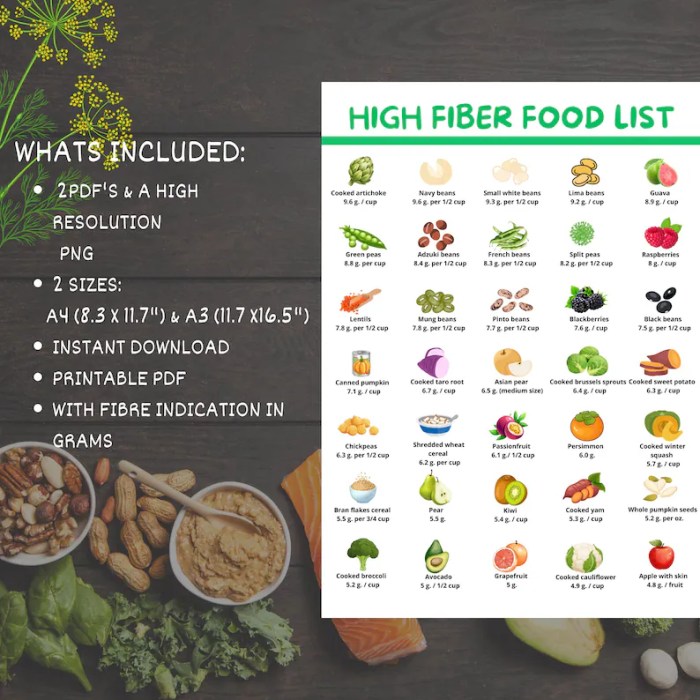
Soluble fiber, a type of dietary fiber, dissolves in water, forming a gel-like substance. Unlike insoluble fiber, which passes through the digestive system largely unchanged, soluble fiber interacts significantly with various bodily processes. Its unique properties contribute to a range of health benefits, making it an important component of a balanced diet.Soluble fiber’s interactions with bodily systems are primarily due to its ability to absorb water and form a viscous gel.
This gel slows down the digestion process, impacting nutrient absorption, blood sugar control, and cholesterol levels. The resulting impact on the digestive system and overall health makes soluble fiber a valuable addition to any diet.
Mechanisms Affecting Blood Sugar Levels
Soluble fiber slows down the absorption of glucose from the digestive tract. This gradual release prevents blood sugar spikes after meals, which is particularly beneficial for individuals with diabetes or those at risk of developing it. The viscous gel formed by soluble fiber traps glucose, delaying its entry into the bloodstream. This controlled release of glucose helps maintain stable blood sugar levels.
For instance, consuming soluble fiber-rich foods like oats or beans can lead to a more gradual increase in blood sugar compared to foods with minimal fiber.
Role in Lowering Cholesterol
Soluble fiber plays a crucial role in lowering cholesterol levels. The viscous gel formed by soluble fiber in the digestive tract binds to cholesterol and bile acids. This complex is then eliminated from the body, effectively reducing the amount of cholesterol circulating in the bloodstream. Studies have shown that diets rich in soluble fiber can lead to significant reductions in LDL (“bad”) cholesterol levels, contributing to better cardiovascular health.
For example, individuals with high cholesterol who incorporate soluble fiber into their diet may experience a measurable decrease in their LDL cholesterol over time.
Impact on Digestive Health
Soluble fiber promotes healthy digestion by adding bulk to the stool and softening it. This increased bulk can help prevent constipation and promote regular bowel movements. The viscous nature of the gel also helps to create a more comfortable and efficient transit of food through the digestive tract. Foods rich in soluble fiber, such as apples and citrus fruits, can help alleviate digestive discomfort.
In addition, soluble fiber acts as a prebiotic, feeding beneficial gut bacteria.
Contribution to Feelings of Fullness and Satiety
Soluble fiber’s ability to absorb water and form a gel-like substance contributes to a feeling of fullness and satiety. This is due to the slowed digestion and increased volume in the stomach. As a result, individuals consuming soluble fiber-rich foods may experience prolonged feelings of fullness, which can help with weight management. This satiety effect is often observed in people who consume foods like chia seeds or flax seeds.
Health Benefits of Soluble Fiber
| Benefit | Mechanism | Example Foods |
|---|---|---|
| Lowered Blood Sugar Levels | Slows glucose absorption | Oats, barley, beans |
| Reduced Cholesterol | Binds to cholesterol and bile acids | Fruits, vegetables, legumes |
| Improved Digestive Health | Increases stool bulk and softens stool | Pears, apples, citrus fruits |
| Increased Satiety | Promotes feelings of fullness | Chia seeds, flax seeds |
Insoluble Fiber
Insoluble fiber, unlike its soluble counterpart, doesn’t dissolve in water. This characteristic gives it a unique set of properties and effects on the body. It plays a crucial role in maintaining digestive health and promoting regularity, distinct from the benefits of soluble fiber. Its bulkiness and structural integrity contribute to the overall function of the digestive system.Insoluble fiber’s primary role is to add bulk to the stool, making it easier to pass through the intestines.
This mechanical action is key to preventing constipation and promoting healthy bowel movements. Its indigestible nature also affects the rate at which food moves through the digestive tract. Understanding these properties is essential for appreciating the significance of insoluble fiber in a balanced diet.
Mechanisms of Promoting Regularity
Insoluble fiber acts like a broom in the digestive tract, sweeping waste through the colon and preventing it from accumulating. This mechanical stimulation is crucial for maintaining regular bowel movements. The increased bulk in the stool created by insoluble fiber speeds up the transit time of food through the digestive system, which reduces the time waste materials spend in the colon.
This faster transit time helps prevent constipation and ensures efficient elimination.
Role in Preventing Constipation
Constipation occurs when stool becomes hard and dry, making it difficult to pass. Insoluble fiber, by increasing stool bulk and softening it, directly counteracts this problem. The added bulk and moisture create a more manageable stool consistency, facilitating easier passage through the intestines. This, in turn, helps prevent the development of constipation and its associated discomfort.
Supporting Digestive Health
Insoluble fiber aids digestive health by promoting the healthy movement of food through the digestive tract. This process is vital for the overall function of the digestive system, from the initial breakdown of food to the eventual elimination of waste. The presence of insoluble fiber prevents the formation of hard, dry stool, a primary cause of digestive discomfort.
It promotes a healthy microbiome by ensuring the efficient removal of waste products.
Impact on Maintaining a Healthy Weight
Insoluble fiber’s ability to increase satiety and promote regularity contributes to weight management. The feeling of fullness after consuming insoluble fiber-rich foods can help control calorie intake. Furthermore, its role in preventing constipation can improve overall digestive well-being, potentially reducing the risk of other digestive issues that might lead to weight gain. This combination of effects can contribute to a healthier weight management strategy.
Comparison of Soluble and Insoluble Fiber Effects on Bowel Movements
| Fiber Type | Effect on Bowel Movements |
|---|---|
| Soluble Fiber | Forms a gel-like substance in the digestive tract, slowing down the passage of food and promoting a softer stool. |
| Insoluble Fiber | Increases stool bulk and promotes faster transit time through the intestines, resulting in larger, softer stools and increased regularity. |
Fiber and Digestive Health
Fiber, a crucial component of a healthy diet, plays a significant role in maintaining digestive well-being. It’s not just about feeling full; fiber directly impacts the function of our entire digestive system. Understanding how different types of fiber affect digestion is key to achieving optimal digestive health.A balanced intake of both soluble and insoluble fiber is essential for a healthy digestive system.
The unique actions of each type contribute to the overall health and well-being of the gut. Inadequate fiber intake can lead to various digestive issues, while incorporating fiber into a balanced diet offers a plethora of benefits.
The Importance of Balanced Fiber Intake
A balanced intake of both soluble and insoluble fiber is vital for optimal digestive health. Soluble fiber, like that found in oats and beans, absorbs water, forming a gel-like substance that slows down digestion and helps regulate blood sugar levels. Insoluble fiber, found in whole grains and vegetables, adds bulk to the stool, promoting regular bowel movements and preventing constipation.
The synergistic effect of both types is crucial for maintaining a healthy gut microbiome and overall digestive function.
Soluble and insoluble fiber are both crucial for a healthy digestive system. While soluble fiber helps lower cholesterol, insoluble fiber promotes regularity. Interestingly, some studies suggest that certain foods, like garlic, might also contribute to healthy blood pressure. For example, discovering if garlic actually lowers blood pressure is a topic that’s been explored, and you can find more information on does garlic lower blood pressure.
Ultimately, a balanced diet rich in both types of fiber is key to overall well-being.
Consequences of Inadequate Fiber Intake
Insufficient fiber intake can lead to several digestive issues. Constipation is a common problem, as insoluble fiber is crucial for stool bulk. This can lead to discomfort and potential complications. Furthermore, a lack of soluble fiber can impact blood sugar control, potentially increasing the risk of developing type 2 diabetes. Additionally, inadequate fiber intake may contribute to digestive disorders such as irritable bowel syndrome (IBS).
Benefits of Incorporating Fiber into a Balanced Diet
Incorporating fiber into a balanced diet offers numerous benefits beyond digestive health. Fiber promotes healthy bowel movements, which can prevent hemorrhoids and diverticulitis. It also helps regulate blood sugar levels, lowering the risk of developing type 2 diabetes. Moreover, fiber aids in weight management by promoting satiety, making you feel fuller for longer.
How Different Fiber Types Impact Digestion
Soluble fiber’s ability to absorb water and form a gel-like substance slows down digestion, which is beneficial for managing blood sugar levels. This is particularly helpful for individuals with diabetes or prediabetes. Insoluble fiber, on the other hand, increases stool bulk, promoting regular bowel movements and preventing constipation. Both types contribute to a healthy gut microbiome, which is crucial for overall health.
Foods High in Both Soluble and Insoluble Fiber
A diverse diet rich in various fruits, vegetables, and whole grains is key to obtaining both soluble and insoluble fiber. This ensures a comprehensive approach to digestive health.
- Fruits: Berries, apples, pears, citrus fruits (oranges, grapefruit) are excellent sources of both types of fiber. Their high water content also contributes to overall hydration.
- Vegetables: Broccoli, carrots, leafy greens, and sweet potatoes are rich in insoluble fiber, promoting healthy bowel movements. Adding a variety of vegetables enhances the nutritional value of the diet.
- Legumes: Beans, lentils, and peas are outstanding sources of both soluble and insoluble fiber. They also provide protein and other essential nutrients.
- Whole Grains: Whole-wheat bread, brown rice, and quinoa are excellent choices for obtaining both soluble and insoluble fiber. They are key components of a balanced diet and contribute to overall health.
Fiber and Specific Health Conditions
Dietary fiber isn’t just about regularity; it plays a crucial role in maintaining overall well-being. Understanding how fiber interacts with various health conditions can help individuals make informed dietary choices. This section explores the relationship between fiber intake and specific health concerns, highlighting the potential benefits and considerations.
Fiber and Heart Health
Fiber, particularly soluble fiber, has been linked to improved heart health. Soluble fiber can help lower LDL (“bad”) cholesterol levels by binding to cholesterol in the digestive tract and preventing its absorption. This can contribute to a healthier cardiovascular system, reducing the risk of heart disease. Studies have shown that increased fiber intake is associated with a lower risk of heart disease.
For example, a diet rich in fruits, vegetables, and whole grains, which are excellent sources of fiber, can help maintain healthy cholesterol levels and promote cardiovascular health.
Fiber and Blood Sugar Control
Fiber’s role in blood sugar regulation is significant. Soluble fiber slows down the absorption of glucose into the bloodstream, preventing sharp spikes in blood sugar levels after meals. This is particularly important for individuals with diabetes or those at risk of developing type 2 diabetes. A diet rich in fiber can help manage blood sugar levels, improving insulin sensitivity and overall metabolic health.
This effect can be particularly beneficial in preventing post-meal blood sugar fluctuations, a common challenge for those with diabetes or pre-diabetes.
Fiber and Weight Management
Fiber’s impact on weight management is multifaceted. Fiber is naturally low in calories and provides a feeling of fullness, reducing overall calorie intake. Insoluble fiber adds bulk to the stool, which can contribute to a feeling of satiety. This can be especially helpful in weight management programs by reducing the temptation to overeat. A diet rich in fiber can contribute to a healthier body weight by promoting satiety and reducing overall calorie intake.
For example, someone trying to lose weight might incorporate more high-fiber foods like oatmeal, beans, and lentils into their diet.
Fiber and Gut Health
Fiber is a crucial food source for beneficial gut bacteria. These bacteria, often referred to as the gut microbiome, play a vital role in digestion, immunity, and overall health. Insoluble fiber acts as a prebiotic, promoting the growth of beneficial gut bacteria, thus contributing to a healthy gut microbiome. A healthy gut microbiome can improve digestion, boost immunity, and support overall well-being.
For instance, a diet rich in fruits, vegetables, and whole grains can foster a thriving community of beneficial bacteria in the gut.
Fiber Intake for Specific Health Conditions
| Health Condition | Suggested Fiber Intake (grams per day) | Dietary Considerations |
|---|---|---|
| Healthy Individuals | 25-38 grams | Focus on a variety of fiber-rich foods. |
| Individuals with Type 2 Diabetes | 25-30 grams | Monitor blood sugar levels closely and consult with a healthcare professional. |
| Individuals with IBS (Irritable Bowel Syndrome) | 15-25 grams | Introduce fiber gradually to avoid exacerbating symptoms. Consult with a doctor or registered dietitian. |
| Individuals with Inflammatory Bowel Disease (IBD) | 15-25 grams | Work with a registered dietitian to manage fiber intake and tailor a diet that minimizes digestive distress. |
Note: These are general guidelines. Individual needs may vary. Consulting with a healthcare professional or registered dietitian is crucial for personalized recommendations.
Dietary Recommendations and Practical Tips
Fiber is a powerhouse for gut health and overall well-being. But simply adding more fiber to your diet isn’t a magic bullet. A gradual increase is key to avoiding potential digestive discomfort. This section provides practical strategies for incorporating fiber into your daily meals, maximizing its benefits while minimizing any unwanted side effects.
Strategies for Gradual Fiber Increase
Increasing fiber intake too quickly can lead to bloating, gas, and other digestive issues. A gradual approach is crucial for a smooth transition. Start by adding small amounts of fiber-rich foods to your diet, allowing your digestive system to adjust. This gradual increase prevents abrupt changes that can trigger discomfort.
Importance of Water Intake
Fiber absorbs water, making stools softer and easier to pass. Adequate hydration is essential when increasing fiber intake. Drinking plenty of water throughout the day helps prevent constipation and ensures fiber works effectively in the digestive tract. Aim for at least 8 glasses of water daily, and adjust as needed based on your activity level and climate.
Incorporating Fiber into Meal Types
Fiber can be seamlessly integrated into various meal types, transforming your meals into fiber-rich feasts. A balanced diet is key, so ensure a variety of fiber sources throughout your meals.
Understanding soluble and insoluble fiber is crucial for overall health, but did you know it can also indirectly impact conditions like metastatic castration-resistant prostate cancer symptoms? Metastatic castration resistant prostate cancer symptoms can be challenging, and a balanced diet rich in these fibers can contribute to better digestion and overall well-being, potentially aiding in managing some of the side effects.
Focusing on fiber-rich foods like fruits, vegetables, and whole grains is a great way to support a healthy lifestyle, regardless of specific health conditions.
Breakfast
Start your day with fiber-rich breakfast options. Oatmeal, whole-wheat toast with avocado, and berries are excellent choices. A handful of almonds or a small bowl of bran cereal can add a significant amount of fiber to your morning meal.
Lunch
Embrace fiber-rich salads with beans, lentils, or quinoa. Whole-wheat sandwiches on whole-grain bread, accompanied by a side of fruit, provide a good source of fiber. A lentil soup with a side salad is a fantastic lunch option.
Dinner
Choose lean protein sources combined with plenty of vegetables. Brown rice, sweet potatoes, and broccoli are all great choices. A hearty lentil stew with a side of mixed greens or a whole-wheat pasta with a vegetable-based sauce are both fiber-packed dinner options.
High-Fiber Snacks
Snacking on high-fiber foods can help maintain energy levels and promote satiety. These snacks provide a convenient way to add more fiber to your diet.
- Fruits like apples, bananas, and berries are excellent sources of fiber.
- Vegetables such as carrots, celery, and bell peppers are crunchy and fiber-filled.
- Whole-grain crackers and popcorn are satisfying and fiber-rich options.
- Plain yogurt with granola and fruit can also be a great choice.
- A handful of nuts and seeds are a good source of fiber and healthy fats.
Fiber and Food Processing: Soluble And Insoluble Fiber
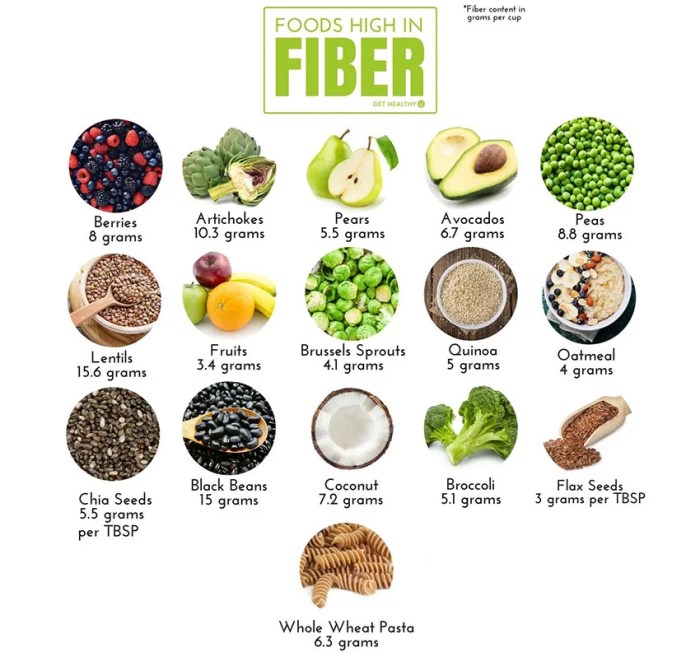
Food processing plays a significant role in the fiber content and overall nutritional value of our food. Modern food production methods often involve intricate steps that can either enhance or diminish the natural fiber present in various ingredients. Understanding these changes is crucial for making informed choices about the foods we consume. This section delves into how food processing affects fiber, highlighting the differences between whole and refined grains, and the impact on our health.Food processing methods, while sometimes necessary for preservation and convenience, can alter the composition of foods, including their fiber content.
This alteration can significantly impact our digestive health and overall well-being. The degree of processing directly correlates with the amount of fiber retained in the final product.
Impact of Refining on Fiber Content
Refining, a common food processing technique, often strips away the bran and germ layers of grains, resulting in a loss of fiber. This process typically aims to improve the appearance, texture, and shelf life of the final product, but it comes at the cost of essential nutrients, including fiber. Refined grains, while readily available and often cheaper, generally contain less fiber compared to their whole grain counterparts.
Nutritional Differences Between Whole Grains and Refined Grains
Whole grains retain the entire grain kernel—bran, germ, and endosperm—providing a more complete package of nutrients. Refined grains, on the other hand, primarily consist of the endosperm, which is the starchy inner part of the grain. This difference in composition leads to distinct nutritional profiles. Whole grains offer a wider array of vitamins, minerals, and fiber, promoting better digestion and potentially lowering the risk of chronic diseases.
Fiber Content Comparison: Whole Grains vs. Refined Grains
The table below showcases the approximate fiber content of various whole grains and their refined counterparts. This comparison highlights the significant difference in fiber density between the two types of grains. Keep in mind that these are approximate values and can vary based on specific preparation methods and growing conditions.
| Grain | Whole Grain Fiber Content (grams per 100 grams) | Refined Grain Fiber Content (grams per 100 grams) |
|---|---|---|
| Brown Rice | 4.0 | 0.5 |
| Whole Wheat Bread | 4.5 | 1.0 |
| Oatmeal (rolled oats) | 8.0 | 2.0 |
| Corn (whole grain) | 6.0 | 1.0 |
| White Bread | 0.5 | 1.0 |
| White Rice | 0.5 | 0.5 |
Fiber and Food Labels
Decoding food labels can be tricky, especially when it comes to fiber. Understanding how fiber content is presented and how to interpret it is crucial for making informed dietary choices. This section will guide you through deciphering fiber information on food labels, helping you identify sources of both soluble and insoluble fiber.
Interpreting Fiber Content on Food Labels
Food labels often provide information about the fiber content of a product, but the presentation can vary. Understanding the different ways fiber is represented will help you accurately assess the fiber in a particular food. This will also help you compare fiber content across different products.
Different Ways Fiber is Presented on Labels
Fiber content on food labels can be presented in various ways. Commonly, the label will list the total dietary fiber content in grams. Sometimes, labels may separately list the total dietary fiber, soluble fiber, and insoluble fiber. This detailed breakdown allows for a more precise understanding of the fiber types present.
Identifying Sources of Soluble and Insoluble Fiber
Identifying the source of soluble and insoluble fiber on a food label can be challenging, as it is not always explicitly stated. Often, the label will simply state the total fiber content in grams. However, you can use the information about the food’s general composition to infer the type of fiber. For example, high-fiber fruits and vegetables are more likely to be rich in insoluble fiber.
Example of a Food Label Highlighting Fiber Content
A hypothetical example of a food label highlighting fiber content:
| Food Item | Serving Size | Total Dietary Fiber (g) |
|---|---|---|
| Oatmeal | 1 cup dry | 8 |
This label shows the total dietary fiber content of a single serving of oatmeal. Other details like the specific type of fiber (soluble or insoluble) may or may not be provided.
Table: Different Ways to Read Food Labels to Identify Fiber Content
| Label Detail | Explanation | Example |
|---|---|---|
| Total Dietary Fiber | The overall amount of fiber in the food. | “Total Dietary Fiber 5g per serving” |
| Soluble Fiber | Fiber that dissolves in water and can help lower cholesterol. | (May be listed separately, if present) |
| Insoluble Fiber | Fiber that does not dissolve in water and can help promote regular bowel movements. | (May be listed separately, if present) |
| Ingredients List | The ingredients list can provide clues about the fiber content, though not always explicit fiber types. | “Oat bran, whole wheat flour” suggests potential high fiber content. |
This table illustrates the various aspects of a food label that provide information about fiber content, enabling consumers to interpret the data effectively.
Final Conclusion
In conclusion, a balanced intake of soluble and insoluble fiber is vital for overall health. We’ve explored the various benefits of each type, from managing blood sugar and cholesterol to promoting regularity and weight management. By understanding the unique contributions of both soluble and insoluble fiber, we can create a personalized dietary plan that optimizes digestive health and supports a vibrant lifestyle.
